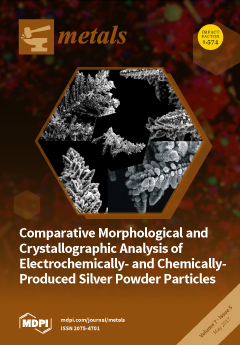In the present study, the effect of Cu content on the microstructure and mechanical properties of die-cast Mg-6Al-2Sm-
xCu (
x = 1, 3, 5) alloys has been investigated. The microstructure and components of the alloys were observed and identified by optical
[...] Read more.
In the present study, the effect of Cu content on the microstructure and mechanical properties of die-cast Mg-6Al-2Sm-
xCu (
x = 1, 3, 5) alloys has been investigated. The microstructure and components of the alloys were observed and identified by optical microscopy (OM), scanning electron microscopy (SEM), transmission electron microscopy (TEM), and energy dispersive spectroscopy (EDS), respectively. The phases of the alloys were analyzed via X-ray diffractometer (XRD). The mechanical properties at different temperatures were studied by tensile tests. The experimental results show that all die-cast Mg-6Al-2Sm-
xCu alloys consist of α-Mg, β-Mg
17Al
12, Al
4Cu
9, Al
3Sm, and Mg
2Cu
6Al
5 phases. These components, i.e., Al
3Sm and Al
4Cu
9 phases, have high thermal stability and can prohibit dislocation movement and grain boundary sliding. TEM analysis shows that the Al
3Sm phase possesses a tetragonal structure. With the increase in Cu content, the microstructure is refined firstly and then becomes coarsened. Moreover, the tensile strength increases firstly and then decreases as Cu content increases at room temperature and an elevated temperature. All fractures of the alloys at room temperature show a complex mode of brittle and ductile fracture. However, at an elevated testing temperature, the fractures of the alloys exhibit more ductile fractures.
Full article





